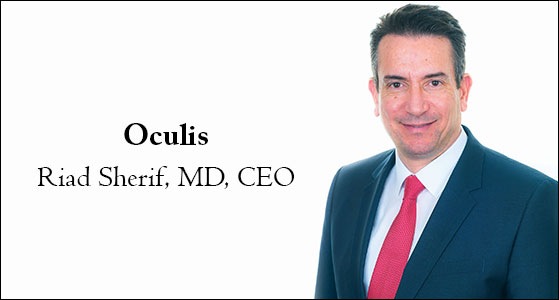CIO Bulletin

Oculis is a clinical stage biopharmaceutical company whose mission is to develop novel topical treatments (eye drops) for ophthalmic diseases for both back- and front-of-the-eye in order to improve the lives of patients worldwide. The Oculis strategy is to build a specialty ophthalmology company unlike any other. Its plan is to further advance the lead candidate, OC-118, for commercialization as a new therapeutic option for Diabetic Macular Edema (DME) patients and to develop a clinical pipeline of topical treatments for back- and front-of the-eye disease based on internal development with its proprietary SNP technology and via complementary in-licensed assets. The company's novel technology provides an unprecedented technical advancement in ocular drug delivery, particularly for back-of-the-eye diseases that are currently managed by invasive methods such as intraocular injections or implants.
OPTIREACH Technology
OPTIREACH is a solubilizing nanoparticle formulation technology that is the result of a meticulous, stepwise approach, over a number of years, by the founders to solve the limitations of conventional eye drops. These limitations include:
Working Principle
The OPTIREACH technology uses a novel formulation approach incorporating selected features of specific cyclodextrins to address the above limitations. The technology leverages unique characteristics of specific cyclodextrin compound to achieve stable formulations containing complex drug/cyclodextrin nanoparticles. The drug/cyclodextrin complexes enhance drug solubility in the aqueous tear fluid and, thus, enhance bioavailability in eye tissues. The drug/cyclodextrin complexes also penetrate the mucous layer and provide sustained drug release. Consequently, drug permeation and bioavailability in the eye tissues are increased. The OPTIREACH solubilizing nanoparticle technology improves both the ability to formulate drugs as eye drops and their bioavailability in the eye tissues including anterior and posterior segments. Existing pre-clinical and clinical data suggest that the OPTIREACH technology can open the way for formulating drugs as effective and well-tolerated topical treatments of retinal conditions with unmet need, including DME. Significant improvement of dosing frequency and tolerability for anterior segment conditions may also be expected.
Antibody Fragment Technology
Topical Anti-TNFα Biologic Candidate OCS-02 is an antibody fragment formulation with potential to become the first approved topical anti-TNFα biologic. It is a proven biological target with possible dual actions: anti-inflammation and anti-necrosis. It offers lower molecular weight allowing for enhanced ocular penetration and higher concentration. OCS-02 is based on an innovative biologic technology that allows for the development of a small, pharmacologically active, humanized single chain variable fragment antibody (scFv). The lower molecular weight of the fragment relative to whole antibody enables the development of a higher formulation concentration enhancing the penetration into ocular tissues . These characteristics make scFv more suitable than full-length antibodies for topical ocular treatment of ocular surface (e.g., DED) or anterior chamber (e.g., AAU) diseases. OCS-02 binds to and neutralizes the activity of human TNFα. TNFα is a proven biological target in systemic and ocular inflammatory conditions and is involved in structural damage to the ocular surface.
Diabetic Macular Edema (DME)
Diabetic eye disease is a group of eye conditions that can affect people with diabetes and it can affect many parts of the eye, including the retina, the macula, the lens and the optic nerve. Diabetic retinopathy is an eye condition that can cause vision loss and blindness in people who have diabetes. It affects blood vessels in the retina (the light-sensitive layer of tissue in the back of your eye). Diabetic macular edema is a consequence of diabetic retinopathy. It is characterized by the swelling of an area of the retina called the macula. DME is the build-up of fluid (edema) in a region of the retina called the macula. The macula is important for the sharp, straight-ahead vision that is used for reading, recognizing faces, and driving. DME is the most common cause of vision loss among people with diabetic retinopathy. About half of all people with diabetic retinopathy will develop DME. Although it is more likely to occur as diabetic retinopathy worsens, DME can happen at any stage of the disease.
DME can be treated with several therapies that may be used alone or in combination. Anti-VEGF Injection Therapy. Anti-VEGF drugs are injected into the vitreous gel to block a protein called vascular endothelial growth factor (VEGF), which can stimulate abnormal blood vessels to grow and leak fluid. Blocking VEGF can reverse abnormal blood vessel growth and decrease fluid in the retina. Available anti-VEGF drugs include Avastin (bevacizumab), Lucentis (ranibizumab), and Eylea (aflibercept). Lucentis and Eylea are approved by the U.S. Food and Drug Administration (FDA) for treating DME. Avastin was approved by the FDA to treat cancer, but is commonly used to treat eye conditions, including DME. Most people require monthly anti-VEGF injections for the first six months of treatment. Thereafter, injections are needed less often: typically, three to four during the second six months of treatment, about four during the second year of treatment, two in the third year, one in the fourth year, and none in the fifth year. Dilated eye exams may be needed less often as the disease stabilizes.
OCS-01: First-In-Class Topical Eye Drop Treatment for Treating DME
OCS-01 successfully completed a Phase 2 trial in DME (DX-211) with 144 patients providing the first proof-of-concept for a topical drug effect in retinal edema. OCS-01 also successfully completed another Phase 2 trial for the treatment of Inflammation and Pain following in Cataract Surgery. Following the completion of both Phase 2 trials, an End of Phase 2 meeting was conducted with FDA and the product candidate is now moving into phase III in both indications. OCS-01 has been developed using the OPTIREACH solubilizing nanoparticle technology, a proprietary platform that enables the formulation of drugs as non-invasive topical treatments, a longer residence time on the eye surface and enhances their bioavailability in the relevant eye tissues. If approved in DME, it has the potential to provide a new and potentially the FIRST non-invasive eye drop option for patients.
OCS-05 – A Potential Disease-Modifying Treatment for Glaucoma
OCS-05 is a first-in-class peptidomimetic small molecule with neuroprotective activity that has shown positive results in animal models of neuroinflammation and neurodegeneration. Its mechanism of action is related to the activation of the trophic factor pathways such as IGF-1 and BDNF. In ophthalmology, this action can protect the nerve axons in conditions where the optic nerve is affected, such as in acute optic neuritis and glaucoma, where the OCS-05 could prevent chronic vision loss. Based on positive preclinical data and results of a phase 1 safety and PK study in healthy volunteers, a phase 2a study was initiated (the ACUITY study) which is currently ongoing in Europe.
Riad Sherif, MD | Chief Executive Officer
Dr. Sherif joined Oculis as Chief Executive Officer in 2017 from Novartis where he served as Entrepreneur in Residence at the Novartis Venture Fund. Since his arrival, the company raised over $100M USD, two successful Phase 2b trials were completed with OCS-01, a positive end-of-phase 2 meeting was conducted with the FDA propelling OCS-01 into Phase 3 for two distinct indications, the OPTIREACH® formulation technology was validated for both: the back- and the front-of-the-eye, and OCS-02, an antibody fragment anti-TNF alpha, was in-licensed from Novartis.
Prior to this, he held senior global positions in both Alcon, where he was President of Europe, Middle East and Africa, and Novartis, where he served as President of Novartis Pharmaceuticals, Canada. Dr. Sherif joined Novartis Pharmaceuticals in 2002 and has also held roles as Head of Transplant and Infectious Disease for Latin America, and President of the Novartis Vaccines and Diagnostics Division for Latin America. During his tenure in Canada and in Europe, he held several Chairman and Co-chair positions such as Vice Chairman for the Innovative Medicine Canada Association in Ottawa, Chairman of In-Vivo Montreal and Chairman of the Board Ophthalmic Surgery and Vision Care at Eucomed, Brussels.
Prior to Novartis, Dr. Sherif worked for several pharmaceutical companies, holding positions of increasing seniority, mainly in marketing and general management with international scope. Dr. Sherif is a medical doctor by training, and also has an MBA from IMD and a Specialized Master’s Degree in Medical Management.







